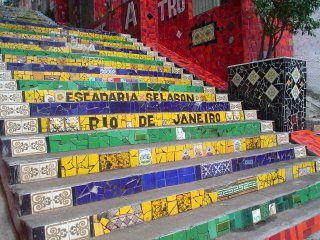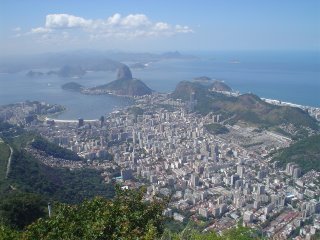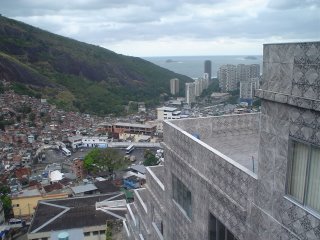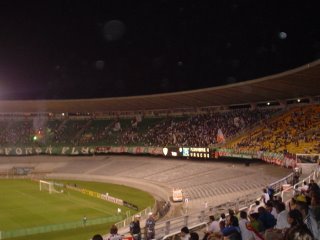Rio de Janeiro

A week ago I returned from a 6-day trip to
Chaos and Order
Chaotic is a fitting word to begin describing
But
Rio’s traffic, noise, crime, pollution, poverty and general disarray make
Given my generalization that Rio is far more chaotic a city than Baires, I must qualify that I found peace and order in two places I thought I never would: in two favelas and in the Maracanã,
Favelas and Villas Miserias
The Brazilian favela (slum) has achieved international infamy for being a hotbed of violence and drugs.
One of my favourite movies, Cidade de Deus, portrays several decades of a government housing project and the evolution of a turf war between rival narco gangs. When trying to imagine a favela, gripping scenes from Cidade de Deus inevitably come to mind.
Given this preconception, I was curious to visit and learn more about
The tour was perhaps the highlight of the trip. Our guide, an Argentine who has been living in a favela for several years, was very informative and open about discussing favela life. Also, some of the proceeds from the tour were donated to an after-school program for kids in the Vila Canoa favela.
The tour started in Rocinha, the largest favela in Rio, and possibly the largest in all of
The government, along with the Inter-American development Bank played an important role in providing basic infrastructure. However, it is the narco gangs that are the ultimate authority in the neighbourhood. Police rarely enter the favela, and if they do, they almost certainly provoke attacks from the drug lords.
This excerpt explains the role of the gangs in much the same way our tour guide presented them:
Rocinha, like many of Rio’s favelas, was under the control of a criminal faction known as the
Given the zero tolerance for delinquency within the favela, our guide explained that Rocinha is a relatively calm and peaceful place. Indeed, I felt more at ease walking around Rocinha than strolling around seedy Avenida Copacabana, the main strip located a block away from the world’s most famous beach.
Our guide emphasized that favelados are generally happy with their neighbourhood and ever since basic services and infrastructure arrived, few have a desire to leave. I found this hard to believe considering the stark differences between the favelas and wealthy neighbourhoods only footsteps away.
For instance, as can be seen in this photo above, at about 200 meters away from Rocinha, lies the residence of a private American school. Monthly tuition at the school runs $3000 reales per month (~$1400 US), while the average family’s salary in the neighbouring favela is 1/10 that amount, at around $350 reales (~$160 US)!
Furthermore, if a family has to subsist on $350 reales, I wondered why the government didn’t lower the high public transportation costs. For instance, the subway costs $2.30 reales (US $1.00) per trip while bus fares usually run between $1.80-$2.15 reales. If someone travels to work twice per day, twenty times per month, that’s $92 reales – one quarter of the average salary spent traveling!
In
While I am making quick generalizations and calculations, I can’t help but think there’s a link between the widespread poverty and stark inequality, and the power of the drug lords. In
It later occurred to me that a statement I heard from an Argentine artisan along Copacabana’s beach, underlies my hypothesis: “Acá hay pocos caciques pero muchos indios. En
He went on to explain that the Argentine disregard for rules and their innate craftiness, contrasted by the deference and laidback attitude of Brazilians, is the reason why villas in
Futebol and Fútbol
Hours upon arriving in
When observing the surprisingly indifferent carioca reaction in the bars and on the streets, as well as reading newspaper headlines the next day, I could tell that this rivalry continues to mean more to Argentines than it does to Brazilians.
A few hours after
While I was pleasantly surprised to observe the relative calm and order of the favelas, I was utterly disappointed by the relative calm and order at the futebol match.
I might as well enjoyed the Maracanã on my own (with a Brahma, of course):
Once the world’s largest stadium, having held over 200,000 fans for the 1950 World Cup Final, and can now can hold around 80,000, the Maracanã was only a third full! The tour guide explained that the Fluminense fans are a wealthier bunch and not all that passionate. They don’t make the trip to the Maracanã since they would rather watch the games in the comfort of their upper class homes. Below is the Fluminense stadium section:
Vasco’s torcida (hardcore fans) managed to make a decent showing (pictured below), but still paled in comparison to the craziness of
Exemplifying that this wasn’t an off-night for the torcidas, were two stadium regulations which would never be permitted in
First, fans were allowed to buy beer during the match. In
As I began to draw these conclusions regarding the relative calm of
In the midst of the jogo bonito, the laidback beer drinking, and the melodic chanting and cheering at a Botafogo-Fluminense match that same week, a torcedero was killed.
At that point, I realized that a lot more joins Rio and









11 Comments:
Hi Diego
I just returned from homecoming weekend in Waterloo and planning has begun for the class of '02 homecoming next fall. If you were in this year can you send me an email at nisha_panchal@hotmail.com so I can pass your information over.
Hope you're doing well,
- Nisha
Hi, first time in your blog. I liked your accounts of Rio, Ive lived there for a year and I think it is my place in the world. I must say Im not sure I share your decision of doing the Favela Tour (not that you should care of course). I believe it's a humiliating attitude (despite what you must have been told that Favela people get some profits from the tour which assist them economicaly) and it's treating poor people as zoo animals. I dont mean to be harsh, and in fact Ive not made my mind yet and that's why I say "im not sure I share" instead of saying I definitely dont share. This is because Ive listened to the point of view of people going on these tours and sometimes I feel that there might be a point in doing them. FOr the time being, I know that I wont be a customer for the company. Hope you return to Rio though, I think it's always a lifetime experience.
Wow, what a small world it really is.
This is Megan, from California... we met through our dear friend in common, miss Kara, when down in BsAs. Can't believe it! I just started a random blog and was missing Argentina so I searched the AR blogs and found yours.
How is everything? Your blog is so interesting and informative, and you are doing some amazing work that I really admire.
Well, escribeme un email si quieres, warner.meg@gmail.com. I regretted not getting your email and it is funny how these things work out. I'm headed back to AR this coming summer I think, as a friend is living down there now. Hopefully we can get in touch again.
Look forward to hearing from you.
Un beso, Meg
ps I posted this on an old entry of yours by accident bc I clearly don't know how to use this program, jajaja ;)
Mas por favor!
I'm an Argentine-transplant-
moved to the States at age 3---
parents didn't speak Spanish to me growing up or connect me to the cultural pockets of Argentines in the States. Struggled with 3rd culture syndrome growing up...seeking to connect more with my roots. Only had one Argentine friend in college. Other than visits to see relatives in Argentina do not have connections with Argentine persons.
Loving reading your blog and absorbing things about my country of origin.
Hope you post more soon!
http://prieslar.info/?search=popkultura
http://prieslar.info/?search=swingers
http://prieslar.info/?search=publikacja+serverow+muonline
http://prieslar.info/?search=Muzyka++sredniowieczu
http://prieslar.info/?search=animal+sex
http://prieslar.info/?search=dzwonki+na+nokie+3100
http://prieslar.info/?search=Hardcore+Candy
http://prieslar.info/?search=szkola+frankfurcka
http://prieslar.info/?search=nosteam+be
http://prieslar.info/?search=Zima+nuklearna
http://prieslar.info/?search=sernik+przepisy
http://prieslar.info/?search=nastolatki
http://prieslar.info/?search=kurnik+de
http://prieslar.info/?search=szalik
http://prieslar.info/?search=wypadki+samochodowe
http://prieslar.info/?search=przepisy+wykonawcze
http://prieslar.info/?search=fm+forum
http://prieslar.info/?search=Plomien
http://prieslar.info/?search=czity+counter+strike
http://prieslar.info/?search=cheaty+do+counter+strike+1+6
http://prieslar.info/?search=Krzysztof+Pazdro
http://prieslar.info/?search=Bron+bojowa
http://prieslar.info/?search=Dora
http://prieslar.info/?search=Frederick+Reines
http://prieslar.info/?search=gogle+earth+plus
http://prieslar.info/?search=Bron+reczna
http://prieslar.info/?search=mod+installer
http://prieslar.info/?search=braterstwo
http://prieslar.info/?search=Taniec+charakterystyczny
http://prieslar.info/?search=Controlling
When you tour, you tour.
快樂,是享受工作過程的結果.......................................................
Post a Comment
<< Home